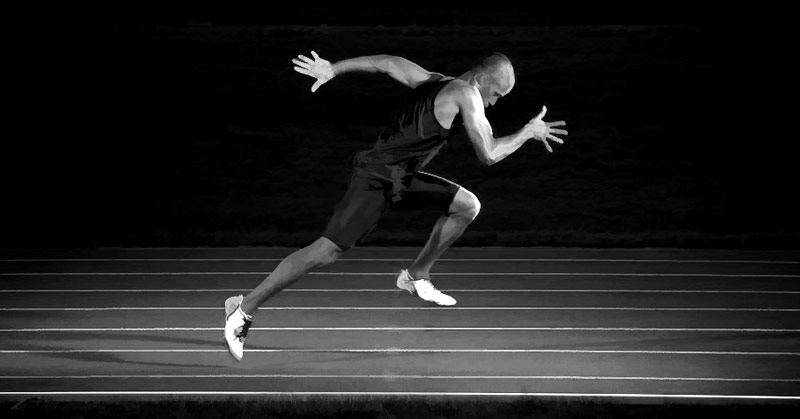
By Carl Valle
When I attended USATF Level I school in 1997, a level III student told me that drills and cues were virtually lies, since the speed of contraction—as well as the very point of most of sprinting—is reflexive in nature. His words upset me, as I wanted cues and magic words to make my athletes go from slowpokes to podium performers.
Events such as swimming are basically artificial techniques and therefore highly dependent on instruction. On the other hand, as the fastest form of human locomotion, sprinting is natural and more innate. So, if cues and verbal commands are likely to be ineffective, why bother with a list—let alone the “five best”? The answer is that just because verbal instruction may have little impact, it doesn’t mean coaches are simply lap counters or motivators. It means only so much transfers from drills and verbal instruction.
A lot of online discussion and debate, especially in the form of interesting tweets, has focused on internal and external cues. Some coaches have publicly attempted to carve out a niche. Don’t drink the Kool-Aid from the false “Holy Grail.” Instead, read up on both the research and reverse-engineer amazing performances by coaches who are making important changes. I have traversed the world wanting to know the truth of what works and have been both amazed and gravely disappointed.
In this article, I will explain what I believe to be true from witnessing coaches and medal-winning sprinters over the last 20 years. I have questioned and peppered the best, and some answers are not glamorous. The brutal truth is that many coaches want to believe they have superhero vision followed by the ability to choose the perfect set of words—almost like casting spells.
It’s hard to know what is working, but over years the video and the performances will tell the story. How one gets there is debatable, as the brain isn’t an easy part of the body to measure and research, but we are learning more. If coaches focus on guiding athletes, things improve with the right environment and direction. But when they push their corrections too much, their athletes’ brains backfire and result in regression or stagnation. You need to do what works, yet provide concrete evidence to yourself and your athletes before believing that a few sentences are working wonders.

Task > Talk or No Cues at All
My favorite cue is explaining a task and demonstrating it, rather than making an internal or external suggestion. Athletes are not drones to control remotely, but living beings wanting to get better. Coaches are obsessed with cues because they believe the answer is themselves, yet most of the time it’s simply a matter of setting up a path to improvement rather than hand-holding.
Instead of being the instructor and teaching, have your athletes acquire skills without having to learn them in the first place. The body is wired to sprint, and as we learn more about the brain, I think Central Pattern Generators will be mapped out. It’s not what to teach or tell; it’s what not to instruct. I had the pleasure of talking to Tom Tellez and appreciated that he was adamant about doing minimal teaching and not overcoaching.
The key in motor skill acquisition is not the magic word or cool phrase, but doing activities that encourage self-organization. Athletes, especially the talented ones, are excellent problem solvers. The goal of teaching is giving the appropriate series of workouts over time rather than hunting for the magic words. Obviously, some instruction is needed, and communication must be enough to nudge athletes forward. For developing maximal speed, it’s much more effective for athletes to sprint fresh and having great talent around the developing ones than using catchphrases.
Simple and consistent exposure to straightforward tasks like repeated sprinting will only need just a touch here and there. Focus on slow progression versus instant change. Also, not tampering with athletes by adding a coach’s perspective retains natural styles of force expression. It also fosters faster improvement instead of constant hammering with suggestions that are right on paper, but slow down the growth process.

High Knee Build Ups
One drill I have never let go of is the classic high knee build up. It’s simple but so effective that every sprinter should employ it at some stage of their career, and refer back when struggling with their maximum velocity mechanics. The drill is as follows: Have athletes run in place with a high knee (not as high as the hip but not lazy, a few inches below the top of the pelvis) and strike the ground like it’s hot—a universal cue we all have probably used. The rhythm is near 80% of the turnover of sprinting and the goal is to increase both horizontal speed and frequency to a full sprint.
The beauty of the drill is that most athletes look great running in place, and it’s easier to hold onto what is right by transitioning into sprinting rather than trying to shout a few words at athletes running at 11 meters per second. Eventually, they are just sprinting naturally—the goal of all instruction. At the very end, the athlete is doing a near-maximal sprint.
The purpose of the sprint drill is not to teach front side mechanics, but encourage the sensation of letting the body do the work by giving back to the track (the Randy Huntington Concept ) versus trying to be strong and applying more force into the ground. I have seen plenty of Instagram photos of hexbar deadlifts with 500 pounds, yet rarely see any sub-10 guy from the Caribbean needing that to run world-class. Again this drill is not teaching mechanics, but allowing athletes to express speed without muscling out or having flat and inelastic running. Audit the drill by timing the sprint zone and seeing how they mature.

Stepping Over High Grass
While in Tampa in the fall of 1996 I saw some sprinters training and noticed the best ones decelerated longer and more gracefully than the slower ones. They seemed to “ride the glide” and constantly reinforced the classic cue of “stepping over high grass.” It’s not perfect, but it does distract the athlete from getting lost in the world of trying to do more to get faster.
The goal of this cue is keeping the pelvis under the body and not trying to override the stretch reflexes of recovery. For years I felt the cue was worthless as knee recovery is not very volitional. But many athletes respond to it by reducing the drive to force things.
When to speak or share this “cue” is up to the coach, but I want the athlete to have the concept of keeping the body balanced and upright and wanting to reduce contact times by not stomping or pushing too long. Reminding the athlete here and there about the sensation of stepping over will create an inspection of the feedback from the track.
At first glance kinetically, the concept of reducing contact times by conscious effort or external instruction may seem false, but the hidden purpose is not about the legs at all. Front side mechanics are about recovery from the same or more forces put into the ground faster, and keeping the hips neutral is not so much core strength but about removing cognitive errors from the natural benefits of reactive motions. Some athletes will lose a little speed by removing forces with overdoing the knee lift and stepping over, but the sensation of automatic and crisp strikes of the ground has worked for many great coaches and sprinters.

Taller, Lighter, Faster
Reinforcing the above tasks is the cue of telling athletes they are significantly lighter and a few inches taller. Verbally instructing an athlete to lengthen and feel lighter is perhaps just a placebo, but I see several changes on video when I have visited coaches who emphasized those two changes. Obviously athletes are not reducing their weight—that would be one amazing cue!—but the purpose is to encourage better hips.
The “getting taller” cue is often designed to get athletes out of sitting, but that’s not an error so much as an attitude towards maximal velocity. Sitting is usually described as an athlete’s center of mass (COM) being too low based on leg length. At midstance, the knee angle should be sufficient to project the COM forward and slightly up to allow recovery of the stride and an increase of speed.
The pelvis will tilt and turn during the sprint cycle, and too much of any motion may be a weakness or joint restriction issue. Sitting or dropping the COM too far, even just slightly, will result in the foot striking too far in front, thus increasing non-propulsive braking forces. Athletes need contact length to create forces, but too much will reduce speed and increase injury rates.
Some coaches use weighted vests to get more out of the cue of being taller. Gravity and fatigue will create bad habits of being saggy and cueing is just reinforcing the sharp posture needed to be sprinting fast. A valid argument is that cueing keeps athletes from being too relaxed. But cues are not going to work if athletes are sitting more than normal, as fatigue tends to cause errors more than poor cueing.
Perhaps the cue is nothing more than removing a lethargic approach to the demanding task of sprinting and making an athlete more alert.

Arm Action Temporal Cueing
Coaching arms for better sprinting technique or more speed is controversial. Some research has returned to investigating the contributions of the arms and core. In the past, the serape effect of the back muscles was thought to keep the torso stiff during sprinting, though it was uncertain how much—if at all—it helped sprinters at maximal speed. Many athletes with great pull-up strength are not faster because they add 45-pound plates during workouts, so that idea has lost favor. I have always been a fan of pulling for the upper body and feel the bench press has value, but strong arms are not making elites any faster.
The only change I have seen occurs when athletes either increase their range of motion too much or reduce it to move their limbs faster. Again, athletes sometimes get fooled by faster limb velocities by shortening the arm action, as the natural sensations feel productive—but any increases in top speed are difficult to detect. Conversely, some athletes over-swing the arms or drum (bend only at the elbow) and this will usually reduce the stride length (leg power) but or feel like one is getting a better push. Most older sprinters graduate away from arm errors, but high school sprinters tend to lack maturity when rushing to improve.
Arm mechanics are highly related to feedback loops from the lower body. Most of the focus involves keeping a solid beat (rhythm) and doing what one has rehearsed at slower speeds. Maximal sprinting is a strange Zen experience and unique, so coaches must work with their athletes to find a set of exchanges in execution that create fast times in training with balanced upper body mechanics. It’s simple, but making sure arms are purposeful and relaxed with the proper range of motion is never easy for everyone.
Closing Thoughts on Cueing and Maximal Velocity
Like some supplements, most cues don’t work at all. If they do, they only complement the meat and potatoes of training. I want cues to work. I like hearing that something out of my mouth changes things with athletes as it’s a special feeling. But the best reward is seeing athletes get better by giving them a spark inside. I am no expert in coaching maximal speed, but I know what doesn’t work for me and what doesn’t work for many elite coaches who are experts.
Use whatever you need to get the job done, but it’s better to say less and plan better than fall in love with talking. Saying something to athletes who are making an error does feel empowering because it seems like you are addressing the issue. Sure, you can remind an athlete of an error and give a cue. However, many issues are not execution problems, but simple errors in fatigue management and physical development from outside variables.
Not everything falls into place in sprinting, and many of the best coaches in the world are juggling injury histories and working with people masterfully. It’s easy to get seduced into looking for the best cues, but only give feedback you know has a chance of being absorbed. A sprinter moving at 4-5 strides a second can’t fix a motion that may need to change in less than a tenth of a second. So it’s better to shape strategies of more controllable elements that set up maximal speed mechanics rather than trying to verbally fix an error.
Please share so others may benefit.
[mashshare]


Great read. I like, and agree with, the concept that a few cues don’t make a successful coach/athlete, but the sum of all aspects of the programme is what counts.